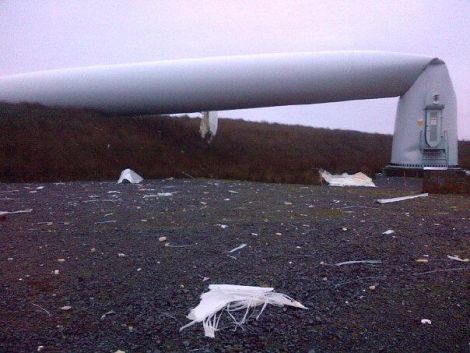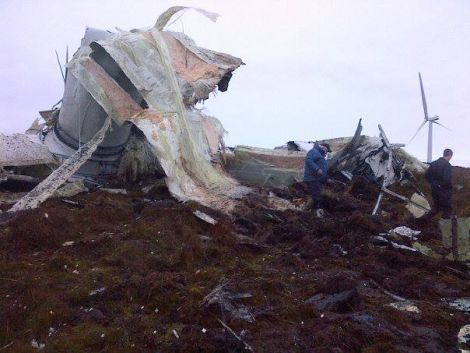Letters / Spinning out of control
Those with an interest in wind farms may be interested to hear about the collapse on Friday 2 January in light winds of an 80 metre tall 2,500kW wind turbine. This turbine was one of eight in the Screggagh wind farm on Murley Mountain in Co. Tyrone.
The industrial sized turbine, valued at over £500,000, collapsed and broke up scattering debris over a wide area. (For sake of comparison the proposed Viking Energy wind farm turbines are 3,600kW and 145 metres tall).
People living in the area said the rotor blades were spinning out of control and sound of the breaking apart was heard more than 11 kilometres (7 miles) away. Debris from the stricken turbine is scattered across the mountainside up to one kilometre away. A large spike is impaled in the earth several hundred metres from the turbine site. (The attached pictures are courtesy of Padraig McDermott).
Turbine collapses such as this are becoming a more common occurrence worldwide with the proliferation of subsidised wind farms. So great is the concern about such incidents that a new rule has been introduced in Bavaria to regulate the minimum distance of turbines from dwellings. This is because turbines planned for this area will be 200 metres tall.
These new rules introduce a formula for minimum distance from dwellings, i.e. setback distance =10 times H where H = the height of the turbine. Thus for a 200 metre tall turbine the setback distance will be (200 metres x10) = 2 kilometres.
The rationale behind this formula is that the basic laws of ballistics tell us that in a turbine break-up scenario blade debris can be projected and bounce to a distance of 10xH. This applies only to turbines on a flat field, for those built on a hillside flying debris would carry and bounce for a much greater distance.
Become a member of Shetland News
Assuming the Viking turbines are only 145 metres tall then the danger zone around them will be 1.45 kilometres (1 mile). In actuality, the danger zone around the Viking turbines will be much greater for they are planned to be built on slopes and on hilltops.
Unlike in Bavaria there is no law in Scotland that imposes the setback of these industrial giants from dwellings but there is a recommended setback distance of 2 kilometres. Viking Energy chose to ignore this recommendation. Why? Because over 70 of the proposed 103 Viking turbines are planned to go up within 2 kilometres of people’s houses. If they had adhered to this recommendation to keep people and property out of the danger zone there would be no Viking wind farm.
Remembering that much of the Viking wind farm is to built on Shetland Islands Council owned land, this is not the first time that Viking Energy, Shetland Charitable Trust and the SIC has played fast and loose with people’s lives and property.
Two years of careful scrutiny by the experts in the SIC planning department recommended that the Viking wind farm was not appropriate for Shetland, yet this was binned in favour of ‘back of the fag packet economics’ for which that (now discredited) council was famous.
There was a Health Impact Assessment that was lauded as “world class” then cancelled by Viking Energy, and a subsequent health investigation was binned by trustees of Shetland Charitable Trust. Before and since then, report after report in medical and scientific journals has come out highlighting adverse health effects of infrasound from wind farms.
Noise, particularly low-frequency noise pollution, impacts negatively on the health of those living within range of the turbines. This includes a variety of symptoms including: sleep disturbance, depression, suicidal tendencies, lack of concentration and energy, tinnitus, breathing difficulties, migraines, nausea, etc. Most worrying of all are reports of deaths of otherwise healthy animals and stillbirths and deformities in newborns and yearlings.
Shetland’s hills carry the highest risk of peat-slides in the British Isles due to its unique topography combined with rainfall patterns. Much of the Viking wind farm will be built in the highest risk areas of Shetland. This is a fact that is ignored by Viking, the SCT and the SIC.
Construction of the industrial complex with its 100 kilometres of access roads to vast quarries and turbine sites will completely change the drainage patterns of the hillsides. Peatslides will be inevitable. Peatslides, like fragmenting turbine blades, can kill. Bearing in mind the close proximity of this industrialisation to dwellings, who is picking up the insurance tab if the wind farm is built?
The sitting Shetland Islands Council that handed over the Viking Energy Project to the Charitable Trust was the same one that over many years got Shetland into a needless financial mire that the present council is trying to claw its way out of.
t was pretty much the same band of incompetents that sat round the table in the Town Hall and denied Shetland (and the residents in the danger zone of the wind farm) the benefit of a Public Local Inquiry where all these concerns could have been addressed.
Will the present 22 that sit around the table in the Town Hall have the guts or the political will to address these concerns by denying Viking turbines access to SIC owned land? I doubt it.
With or without a billion pound interconnector cable the Viking wind farm is not financially viable. It is not environmentally desirable. It is not safe for those living within the danger zone of 70 turbines. Our MP, MSP and our councillors are deluding themselves by thinking that if a fairy godmother pays for an interconnector cable it will ‘unlock a great renewables industry’.
Where do they think this industry is going to find the land on Shetland to build all the extra turbines needed to make their industry viable? A ‘Ring o’ 145 metre tall Roses’ next to their houses? I don’t think so. The wave farm was always a non-starter. The plan of filling in Bluemull Sound to generate electricity just 4 times a day to meet the extra demands of an interconnector is just laughable.
If our councillors and Viking Energy had listened to their own planning department all those years ago then options for an off-grid renewables project for Shetland could have been looked at. If this had happened then perhaps by now we would have a viable off-grid renewables industry appropriate to Shetland supplying power for our own needs.
Allen Fraser
Meal
Hamnavoe
Burra
Become a member of Shetland News
Shetland News is asking its many readers to consider paying for membership to get additional features and services: -
- Remove non-local ads;
- Bookmark posts to read later;
- Exclusive curated weekly newsletter;
- Hide membership messages;
- Comments open for discussion.
If you appreciate what we do and feel strongly about impartial local journalism, then please become a member of Shetland News by either making a single payment, or setting up a monthly, quarterly or yearly subscription.






























































